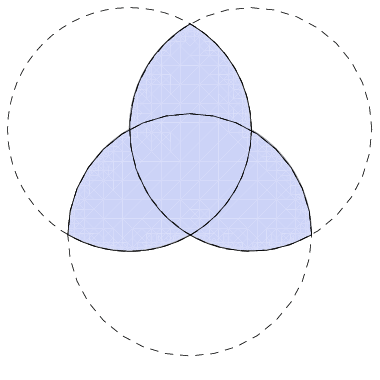Here is a pretty awesome piece of mathematically interesting art I saw the other day.
This shape is called a triquetra. The name comes from the Latin tri- meaning "three" and quetrus meaning "cornered."
It is analogous to the trefoil knot - what you get when you tie a simple overhand knot and join the two ends.
Another way to find a triquetra is to look at the intersection of three circles, like a Venn diagram. (Note that the shape formed at the very center is a Reuleaux triangle, a shape of constant width, deserving of a blog post all of its own...another day)
The triquetra is often shown interlaced with a circle and is common to Celtic art. It has many meanings throughout various religions and symbolizes things that are threefold - mind, body, soul; past, present, future; Father, Son, Holy Spirit; to name a few.
And if that wasn't cool enough, here's another cool thing you can do - take a strip of paper, give it three half-twists, and join the two ends into a three twist Möbius strip.
Then, cut the strip in half along the middle of the strip. After some rearranging and playing with the twists, BAM! Trefoil! How awesome is that?
For further exploration:
- Draw a triquetra - link
- Animation of Möbius strip to trefoil knot - link
- George Hart shows how to cut a bagel into a trefoil knot for some "mathematically correct breakfast" - link




























